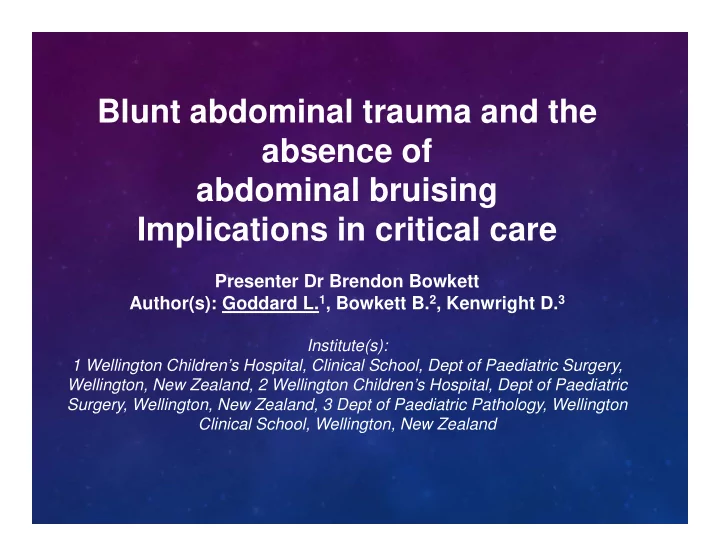

Blunt abdominal trauma and the absence of abdominal bruising Implications in critical care Presenter Dr Brendon Bowkett Author(s): Goddard L. 1 , Bowkett B. 2 , Kenwright D. 3 Institute(s): 1 Wellington Children’s Hospital, Clinical School, Dept of Paediatric Surgery, Wellington, New Zealand, 2 Wellington Children’s Hospital, Dept of Paediatric Surgery, Wellington, New Zealand, 3 Dept of Paediatric Pathology, Wellington Clinical School, Wellington, New Zealand
NO DISCLOSURES
Traumatic death from NZ STATS child abuse is common in NZ • NZ currently ranked 25 th out of 27 OECD countries in respect to child deaths from Maltreatment ? • Approximately 23,000 children suffer from abuse or neglect in NZ each year? (2012/13) • Equates to 3-4% of child population of NZ
Duodenal Perforations in children under 4 (nonMVA) Child abuse a most likely cause. • Bowkett et al ANZ J Surg 1998 Vol 68 • 14 year review 7 cases 5 cases child abuse 2 MVA • No case due to falls or objects falling • Falls leading cause of admission • Pokorny et al JPS 1986 only one case due to child abuse. ( objects falling on or child falling)
• Bowkett et al ANZ J Surg 1998 vol 68 • 4/5 cases due to abuse had no evidence of abdominal bruising even with delayed presentation
TRAUMATIC RUPTURE OF DUODENUM Ruptured duodenum Identify abuse Protect the child Document evidence
TRAUMATIC RUPTURE OF DUODENUM Abdominal wall Duodenum Vessels within abdominal wall
TRAUMATIC RUPTURE OF DUODENUM Vessels within abdominal wall stretch with the force Punch/blow to the abdomen Duodenal injury
2003 Gaines et al (Pittsburg) JPS 2004 Vol 139 8 year review of duodenal trauma including perforations All children < 4 with perforations in non MVA (n=3) mechanism (child abuse) 2/3 initially diagnosed with appendicitis due to absence of abdominal wall bruising
PURPOSE Our hypothesis to explain this observation is that subcutaneous blood vessels in small children have enormous elasticity. When a small paediatric abdomen is subjected to a diffuse force, such as from a punch, the elasticity of the vessels prevent rupture and hence no bruise is formed. Our study investigated the degree of elasticity in the abdominal wall vessels of young children.
METHODS 20 children aged less than five years who received routine elective hernia or orchidopexy repair were included in our study. After a standard skin incision, the wound edges were distracted and the subcutaneous blood vessels identified. Vessels were secured with artery forceps at the margins of the wound and the length of the vessel between the forceps recorded without applying any tension. The vessels were then stretched maximally and their length under tension recorded.
VESSEL MEASUREMENT Subcutaneous vessel at resting length Subcutaneous vessel under tension
RESULTS Vessels routinely could be easily distracted up to 3 times their resting length without rupture.
TABLE OF RESULTS Age Vessel Length Vessel Length Increase in Length (months) Resting (mm) Max Stretch (mm) (Ratio) 9M 4mm 19mm 4.8 3M 6mm 17mm 2.8 15M 8mm 28mm 3.5 19M 7mm 24mm 3.4 11M 4mm 16mm 4.0 29M 12mm 32mm 2.6 18M 8mm 24mm 3.0 6M 4mm 19mm 4.7 3M 4mm 10mm 2.5 24M 6mm 17mm 2.8 11M 5mm 20mm 4.0 11M 4mm 21mm 5.2 22M 5mm 22mm 4.4 13M 5mm 12mm 2.4 24M 6mm 17mm 2.8 16M 9mm 25mm 2.8 21M 9mm 21mm 2.3 23M 7mm 18mm 2.6 20M 4mm 14mm 3.5 27M 6mm 21mm 3.5 Average: 3.3
RESULTS Venule Arteriole This was true for both arterioles and venules, as confirmed by subsequent histology.
RESULTS Also when maximal stretch was achieved considerable more force was then required to rupture the vessel.
CONCLUSIONS: 1. Subcutaneous vessel flexibility is likely the reason why severe diffuse forces that can cause major intra- abdominal trauma are not necessarily associated with abdominal bruising. 2. Paediatric surgeons commenting on mechanisms of injury in suspected child abuse cases need to consider these research findings. The absence of clinically visible abdominal bruising is often still associated with severe intra-abdominal disruption in blunt trauma due to child abuse.
Recommend
More recommend